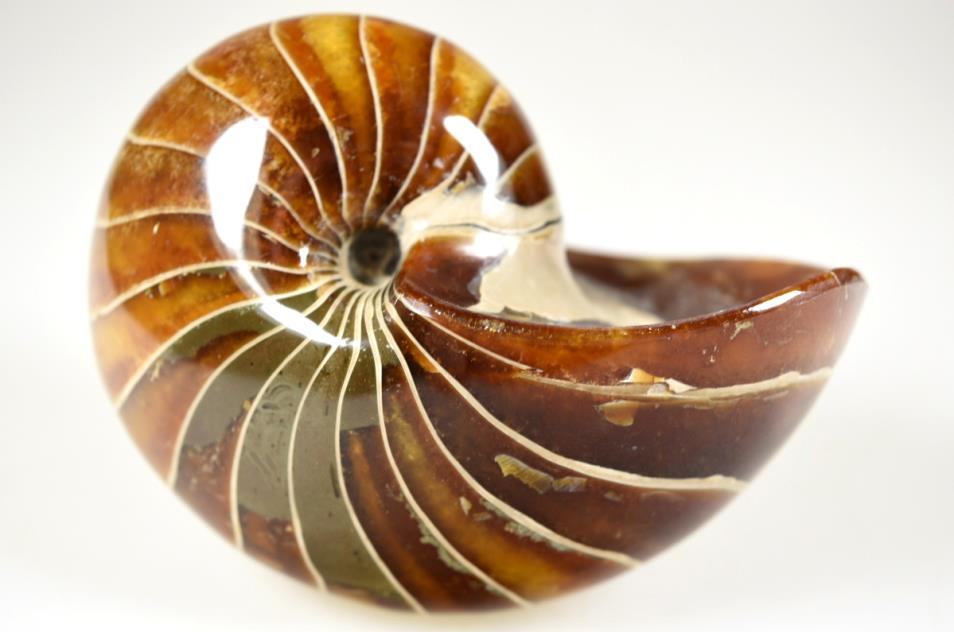Types of Fossils A-Z
What Are Ammonites?
Ammonites are a group of extinct molluscs which somewhat resembled a shelled squid when they were alive.
These ancient sea creatures had tentacles like the modern octopus, and spiral shells like Nautilus creatures.
They first appeared on the fossil record 240 million years ago, in the Triassic Period, and died out 65 million years ago with the dinosaurs during the Cretaceous-Tertiary Mass Extinction Event.
The fossilised remains of these sea creatures are perhaps the most popular fossils on the market today.
How Old Are Ammonites?
Most of the ammonite fossils available from Hidden Earth date back to the Cretaceous Period at 120 million years old: including our ammonites of species such as Cleoniceras, Phylloceras, and Lytoceras.
Perisphinctes Ammonites are the oldest fossils we have available, and date from the Triassic Period, at 248 million years old!
Where Do Ammonites Come From?
Most of our ammonites were originally found in the jungles of Mahajanga on the North West Coast of Madagascar.
How Do Ammonites Become Fossils?
When an ammonite creature died, it became fossilised in the process as follows:
- Ammonite bodies sunk into the seabed sediment, and over time the many sediment layers hardened into rock, preserving the fossils within.
- Throughout this process, bacteria decomposed the ammonite bodies.
- This decomposition affected redox conditions in the marine environment, leading to dissolved minerals such as carbonates and phosphates becoming less soluble in water.
- The minerals were precipitated out of the water, and enveloped the ammonite in a solid concretion, which ensured the fossil and its ammonite shell was preserved for thousands of millennia.
- Some minerals such as calcite seeped into the ammonite remains, leading to mineral replacements and ornately coloured interiors.
- The rock covering the ammonite fossils was then either naturally eroded, or excavated by humans, to expose the fossils.
Ammonites History And Myth
Greek myth gifted the fossils with their famous name; the coiled shell of this ancient marine mollusc resembles the horns of rams, therefore its remains were classified as ‘ammonites’, after the Greek ram god Ammon.
in India, the fossils are still referred to as ‘Shaligrams’ (or ‘Saligrams’) and worshipped as representations of the Hindu God Vishnu.
To many Hindus these stones are sacred, for they have the power to expel bad karma and cleanse people of sin before their death, enabling them to enter the afterlife.
Sacred Geometry Of Ammonite Shells
In sacred geometry, the spiral shape has powerful spiritual significance, and signifies growth and expansion.
As ammonite shells display distinctive spiral shapes, ammonites embody this spiritual meaning of growth too.
An ammonite shell is a perfect example of the sacred Golden Mean Spiral, a symbol of the infinite Fibonacci Sequence and the revered Golden Ratio.
As a result, ammonites are believed to be strongly symbolic of order and perfection in not just the natural world, but the entire universe.

Cut and polished Ammonite Pairs displaying gorgeous Yellow Calcite chambers
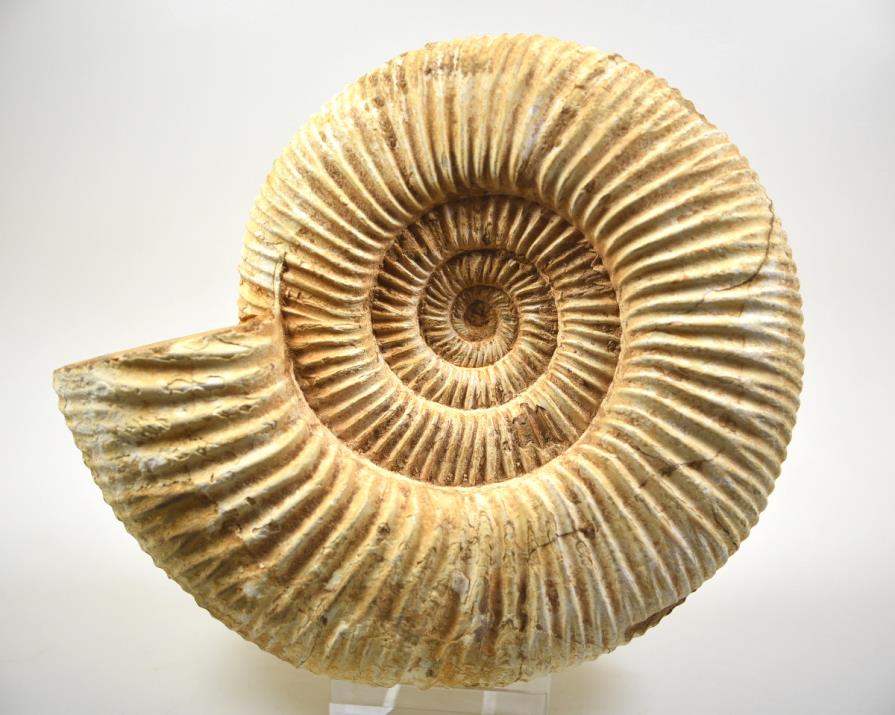
Natural Perisphinctes Ammonites: over 248 million years old!

Polished Phylloceras Ammonites with intricate fern-like suture patterns
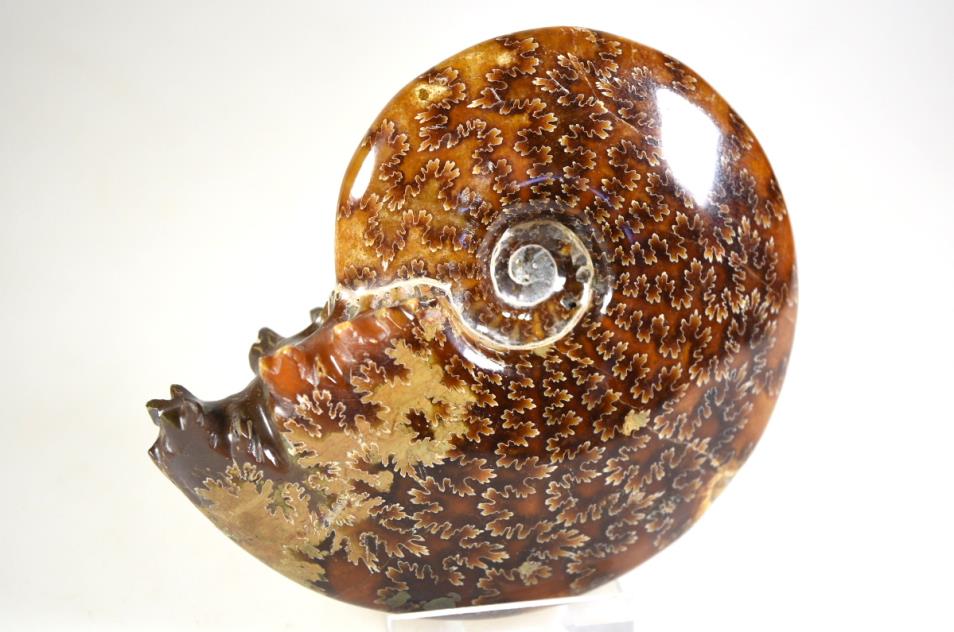
Polished Cleoniceras Ammonites from Madagascar
What are Echinoids?
Echinoids are fossilised sea urchins: the name "Echinoid" is derived from the Greek terminology for "spiny skin" in reference to the spines present in living sea urchins.
Modern forms of Clypeasteroid Echinoids are sometimes known in their living form as sand dollars, or as sea biscuits (owing to their mostly flat shape).
Where do Echinoids come from?
Demonstrating fantastic definition and rich ivory, beige and caramel colours, our Echinoid Fossils are sourced from the Tulear region of Madagascar.
How old are Echinoid Fossils?
Dating at around 145 to 200 million years old, our Echinoids originate from the middle of the Jurassic period.
What do Echinoids look like?
Fossilised Echinoids display a pattern resembling the petals of a flower; the five branches upon their surfaces were used by the living sea urchins for gas exchange and respiration.
When the sea urchins were alive, these branches were lined by tube feet which were used to transport food to the creature's mouth, located at the centre of the petal pattern from which the branches radiate.
Echinoid Fossils at Hidden Earth
Our intricate Echinoids are prime examples of high-grade Jurassic Period fossils, and have been carefully hand-polished upon their natural surfaces to ensure they glisten and shine.
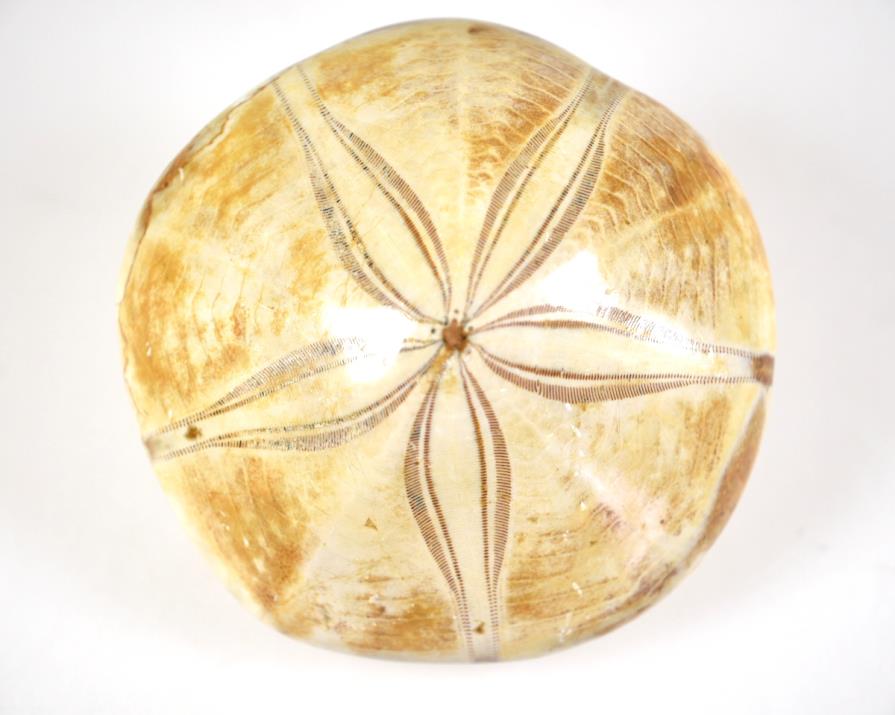
Echinoid Fossils are the fossilised remains of ancient sea uchins
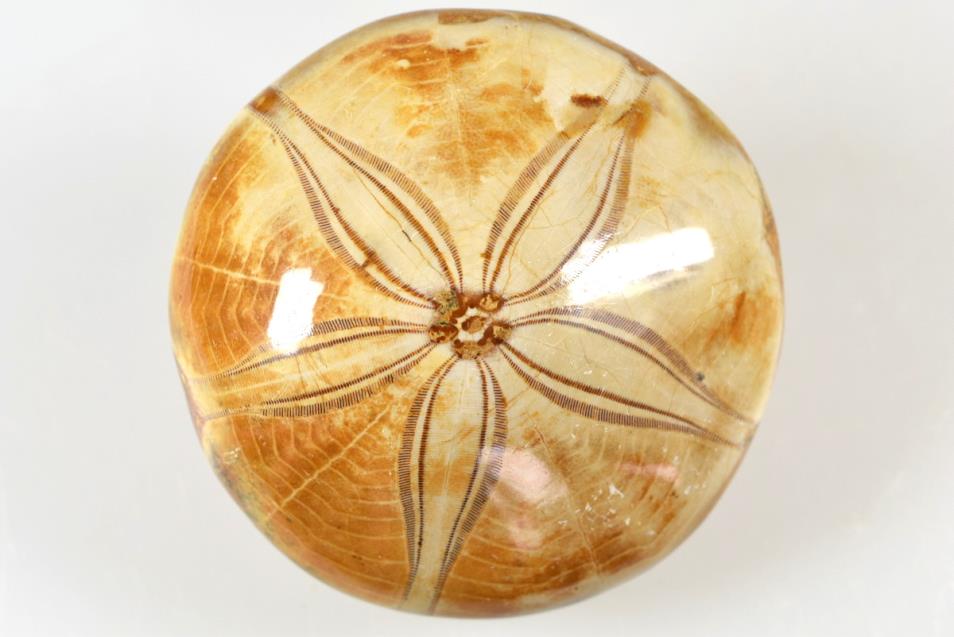
What is Fossil Wood?
Fossil Wood, otherwise known as Petrified Wood or Fossilised Wood, is a tree fossil primarily composed of silicate minerals such as Jasper.
These ancient trees grew millions of years ago, and after death, the original wood material was replaced by colourful Jaspers, creating the Fossil Wood we find today.
How does Fossil Wood form?
The process of fossilisation which forms Fossil Wood is termed permineralization, which describes how mineral replacements create these stunning fossils.
The process is as follows:
- Trees and plants grew millions of years ago
- .The trees and plants died and their remains were buried in sediment such as volcanic ash or river sediment.
- As the plants were encased in the sediment, they were protected from decay and remained preserved.
- Eventually, water rich in dissolved minerals, usually silicates, flowed through this sediment which contained the plant remains.
- These colourful minerals were precipitated out of the water into solid form, and entered the wood, replacing the original plant material.
- Over time, the original wood material was completely replaced by these minerals such as Quartz or Chalcedony (Jasper).
Where does Fossil Wood come from?
We have just received a new, unique batch of Fossil Wood sourced from Madhya Pradesh in India, where it is sometimes referred to as 'Trees of Stone': this wood is over 40 million years old!
How hard is Fossil Wood?
Measuring 6.5 to 7 on the Mohs scale, this Jasper-based mineral is relatively hard and durable and resistant to scratching, but care should still be taken not to damage its polished surface.
Why do fossil collectors collect Fossil Wood?
Due to the diversity of colour and pattern in each individual piece of Fossilised Wood, this type of fossil is incredibly popular in fossil collections worldwide.
Crystal healers also prize this stone for the reported healing properties of Petrified Wood.
What does Fossil Wood look like?
At Hidden Earth, our Fossil Wood comes in a variety of forms, ranging from cut and polished Fossil Wood Slices, to large Fossil Wood Branch Ends and Fossil Wood Logs.
We also have a large selection of Fossilised Wood which has been cut into crystal Freeform Shapes, Spheres, Eggs, Hearts, and Palm Stones: these polished pieces are perfect for crystal dealers interested in Petrified Wood.
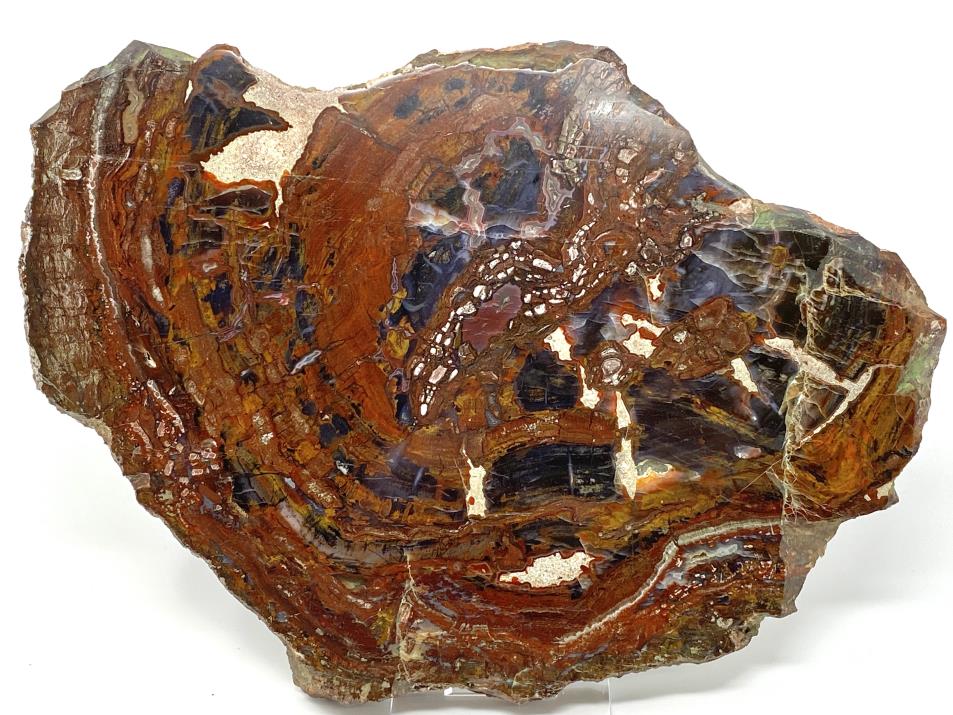
Fossil Wood sourced from India, dating at over 40 million years old

Black Fossil Wood Slice from Madhya Pradesh, India
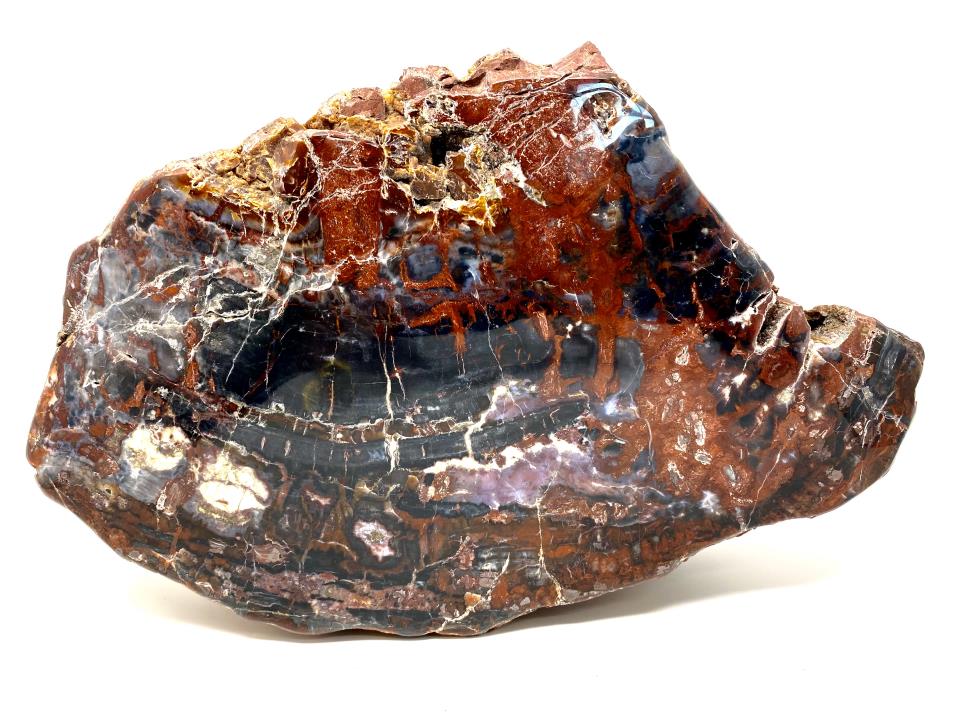
Large Fossil Wood Log polished on one face to reveal colourful Jasper replacements
What are Iridescent Ammonites?
Iridescent Ammonites are ammonites which display an iridescent nacreous shell: when light is shone upon the surface of the shells, a rainbow of colour flashes from the iridescent shell.
Where do Iridescent Ammonites come from?
Gem quality iridescent ammonite shells are most famously found in Canada, where they are called "Ammolite": this gem is the official gemstone of Alberta.
However, our high-grade iridescent ammonites are sourced from the jungles of Mahajanga on the North West Coast of Madagascar, an island famed for its riches of fossils and crystals.
How old are Iridescent Ammonites?
Our Iridescent Ammonites date back to the Cretaceous Period at 120 million years old.
What are Iridescent Ammonites made of?
The iridescent shell of an ammonite is formed from the mineral Aragonite, a component of Nacre (also known as Mother of Pearl).
This nacreous shell, with its rainbow colours, is what is turned into gemstones such as Ammolite.
Gem ammonites such as red iridescent ammonites are called biogenic gemstones (the only other gems of this type are pearl and amber) because they are formed from the fossilised organic material of once living creatures.
Minerals in Ammonites
Fossilised ammonites are also full of minerals such as Calcite and Pyrite, as well as trace elements such as copper.
The composition of each ammonite can vary greatly due to the different minerals that seeped into it as it decomposed and fossilised.
What makes an Ammonite iridescent?
The distinctive colour, lustre, and opal-like effect of iridescent ammonites is caused by their Aragonite shells.
Inside the shell, there are many stacked layers of Aragonite which light must travel through.
As light bounces through the layers of Aragonite, a rainbow spectrum of colour can be observed, caused by the interplay of light travelling through the layers.
- Thick layers of Aragonite typically leads to shades of red being observed
- Thinner layers of Aragonite often result in shimmering greens
- The thinnest layers of Aragonite lead to blue and violet hues being observed
Chromatic Shift- Colours That Move!
As you twist and turn an iridescent ammonite in the presence of light, one can observe the colours moving, changing, and flashing in what is known as chromatic shift.
Red Iridescent Ammonites at Hidden Earth
At Hidden Earth, we have a large selection of high-quality Red Iridescent Ammonites available for sale.
Due to their fiery hues, Red Iridescent Ammonites are often referred to as Fire Ammonites, or alternatively, Opalescent Ammonites (in reference to their opal-like appearance).
Our Red Iridescent Ammonites display stunning chromatic shift, and often display gorgeous flashes of green amongst their red hues.

Red Iridescent Ammonites sourced from Mahajanga, Madagascar: dating at 120 million years old from the Cretaceous Period

Iridescent Ammonite Fossils of the Cleoniceras species, displaying iridescent red colours

Iridescent Ammonites displaying chromatic shift and fern-like suture patterns
What are Nautilus Fossils?
Nautilus Fossils are the fossilised remains of ancient marine molluscs.
How old are Nautilus Fossils?
Nautilus Fossils available from Hidden Earth date back to the Cretaceous Period at 120 million years old, in an era when the seas were full of Ammonite and Nautilus creatures that over time fossilised into the stunning specimens found today.
Nautilus still exist in the present day, and they inhabit the deep coral reefs of the Indo-Pacific Ocean.
These live Nautilus creatures are termed "living fossils": a rare type of creature which is very similar in biology to its ancient fossil relatives.
Where do Nautilus Fossils come from?
Our Nautilus fossils were found in the jungles of Mahajanga on the North West coast of Madagascar, an island located off the East coast of Africa.
What do Nautilus Fossils look like?
Nautilus Fossils display rich caramel and brown colours in intricate striped patterns.
These colours were caused by colourful calcite minerals replacing the original organic material present in the live Nautilus during the fossilisation process.
Some Nautilus fossils display striped black shells: these stunning black hues were caused by natural oil seeping into the shells, colouring the Calcite.
Nautilus specimens at Hidden Earth have been carefully hand-polished to the highest grade, enhancing the vivid colours of their shells.
Sacred Geometry of Nautilus Shells
In sacred geometry, the spiral shape has powerful spiritual significance, and signifies growth and expansion.
As Nautilus shells display distinctive spiral shapes, Nautilus fossils embody this spiritual meaning of growth too.
A Nautilus shell is a perfect example of the sacred Golden Mean Spiral, a symbol of the infinite Fibonacci Sequence and the revered Golden Ratio.
As a result, Nautilus shells are believed to be strongly symbolic of order and perfection in not just the natural world, but the entire universe.
Ammonite shells are also thought to be sacred for this reason.
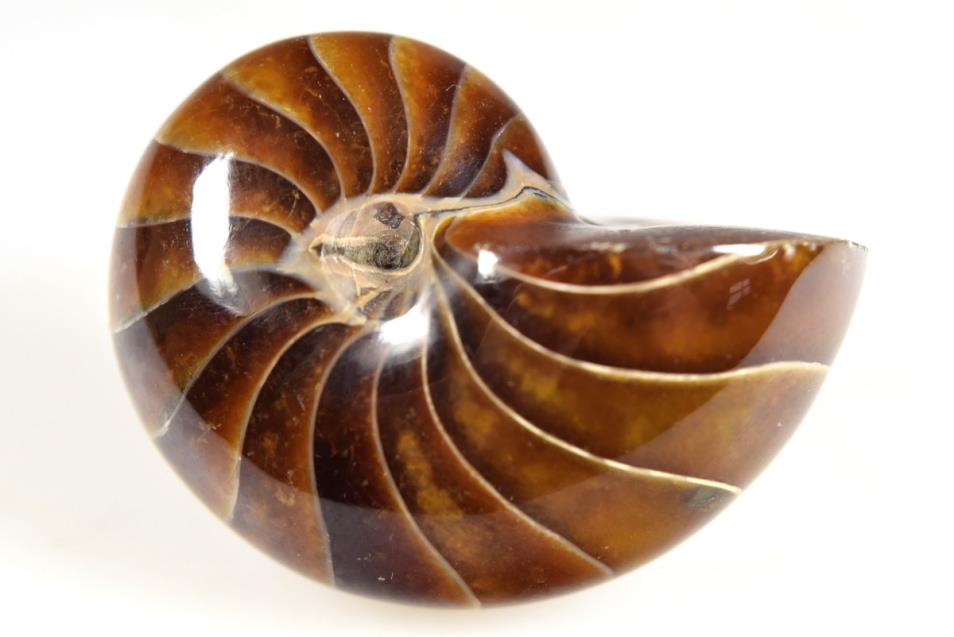
Nautilus fossils dating from the Cretaceous Period: over 120 million years old
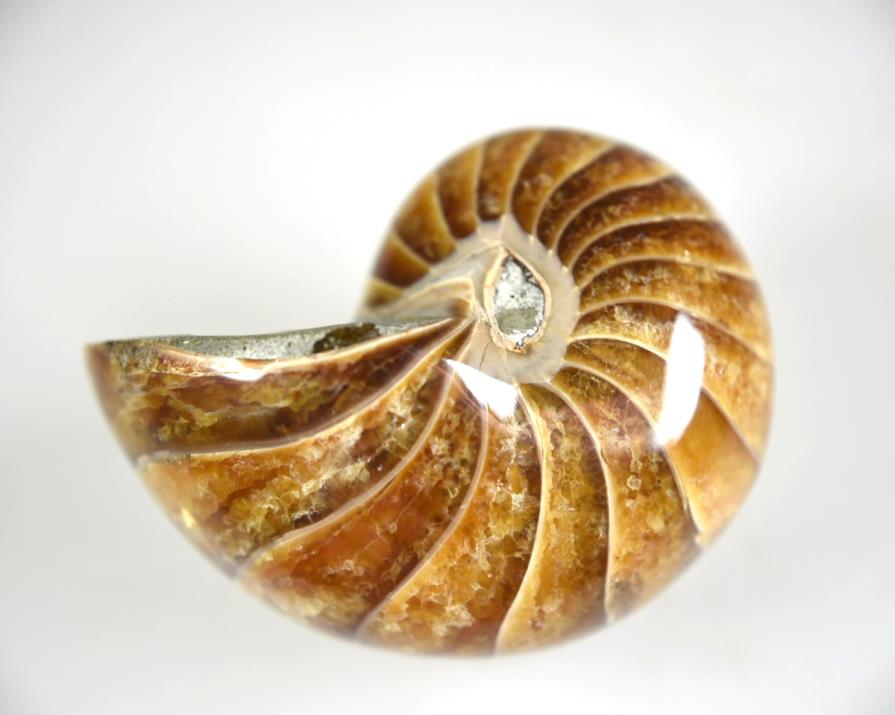
Nautilus Fossils: specimens discovered in Mahajanga, Madagascar
